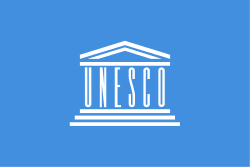Incheon
Incheon (Korean: 인천; Hanja: 仁川; Korean pronunciation: [intɕʰʌn]; McCune-Reischauer romanization Inchŏn; literally "kind river"), officially the Incheon Metropolitan City (인천광역시), is a city located in northwestern South Korea, bordering Seoul and Gyeonggi to the east. Inhabited since the Neolithic, Incheon was home to just 4,700 people when it became an international port in 1883. Today, about 3 million people live in the city, making it South Korea's third most-populous city after Seoul and Busan.
Incheon 인천시 | |
|---|---|
Metropolitan City | |
| Incheon Metropolitan City 인천광역시 | |
| Korean name transcription(s) | |
| • Hangul | 인천광역시 |
| • Hanja | 仁川廣域市 |
| • Revised Romanization | Incheon Gwang-yeoksi |
| • McCune-Reischauer | Inch'ŏn Kwang'yŏkshi |
   Clockwise from top: Incheon International Airport, Nam District, Incheon Football Stadium, Incheon Port | |
 Flag  Seal of Incheon | |

| |
 Incheon 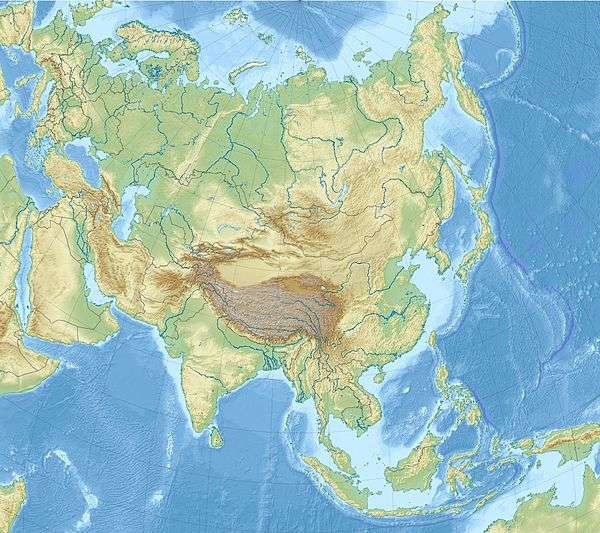 Incheon | |
| Coordinates: 37°29′N 126°38′E | |
| Country | |
| Region | Seoul National Capital Area |
| Founded | 18 BC as Michuhol 1995 AD as Incheon Metropolitan City |
| Subdivisions | List
|
| Government | |
| • Type | Mayor-Council |
| • Mayor | Park Nam-chun (Democratic) |
| • Body | Incheon Metropolitan Council |
| Area | |
| • Total | 1,062.63 km2 (410.28 sq mi) |
| Population (February 2020)[1] | |
| • Total | 2,954,955 |
| • Density | 2,800/km2 (7,200/sq mi) |
| Time zone | UTC+9 (Korea Standard Time) |
| Dialect | Gyeonggi |
| Flower | Rose |
| Tree | Tulip tree |
| Bird | Crane |
| Website | english.incheon.go.kr |
The city's growth has been assured in modern times with the development of its port due to its natural advantages as a coastal city and its proximity to the South Korean capital. It is part of the Seoul Capital Area, along with Seoul itself and Gyeonggi Province, forming the world's fourth largest metropolitan area by population.
Incheon has since led the economic development of Korea by opening its port to the outside world, ushering in the modernization of Korea as a center of industrialization. In 2003, the city was designated as Korea's first free economic zone. Since then, large local companies and global enterprises have increasingly invested in the Incheon Free Economic Zone, including Samsung which chose Songdo International City as its new investment destination for its bio industry.
As an international city, Incheon has held numerous large scale international conferences, such as the Incheon Global Fair & Festival in 2009. The 17th Asian Games Incheon 2014 was also held in Incheon on 19 September 2014. Incheon has established itself as a major transportation hub in northeast Asia with the Incheon International Airport and Incheon Port. The city is also home to the Green Climate Fund, an international organization addressing environmental issues.
History
The first historical record of the Incheon area dates back to 475 CE, during the reign of King Jangsu of Goguryeo, by the name of Michuhol, which is supposed to be located on today's Munhak Hill (문학산). The area underwent several name changes with successive kingdoms and dynasties. In Goryeo era, Incheon was called Gyeongwon (경원) or Inju (인주). The current name was turned to Incheon in 1413. Later, Incheon County became Incheon Metropolitan Prefecture (dohobu, 도호부). Old Incheon consisted of today's southern Incheon (i.e. Jung-gu, Dong-gu, Nam-gu, Yeonsu-gu, and Namdong-gu) and northern part of Siheung City. The city centre was Gwangyo-dong, where the prefecture office (도호부청사) and the local academy (hyanggyo, 향교) were located. The "original" two remaining buildings of the Incheon prefecture office are located in Munhak Elementary School, while the newly built (in 2001) prefecture office buildings are right across from Munhak Baseball Stadium.
Another historical name of the city, Jemulpo (alternatively Romanized as Chemulpo), was not widely used until the opening of the port in 1883.[2][3] After the opening of the Incheon port, the city centre moved from Gwangyo to Jemulpo. Today, either Jemulpo or Gwangyo-dong is considered "Original Incheon" (원인천). It was renamed as Jinsen during Japanese rule in the Korean peninsula.
In 1914, the Japanese colonial government merged outer parts of old Incheon (including the former centre of Gwangyo) with Bupyeong County, forming Bucheon County. Through 1936 and 1940, some part of Bucheon County was recombined into Incheon City, by which some part of "old" Bupyeong was annexed into Incheon.
Incheon was originally part of Gyeonggi Province, but was granted Directly Governed (now Metropolitan) City status on July 1, 1981; the city officially separated from the province. In 1989, neighbouring islands and Gyeyang township of Gimpo County[4] were ceded to Incheon and in 1995 Geomdan township of Gimpo Country and two counties of Ganghwa and Onjin were annexed to Incheon Metropolitan City.
Incheon was known as Inchon prior to South Korea's adoption of a new Romanization system in 2000.
Major events
The city was the site of the Battle of Chemulpo Bay, where the first shots of the Russo-Japanese War were fired.
During the Korean War, Incheon was occupied by North Korean troops on 4 September 1950. Eleven days later, Incheon was the site of the Battle of Inchon, when United States troops landed to relieve pressure on the Pusan Perimeter and to launch a United Nations offensive northward. The result was a decisive UN victory and it was recaptured on 19 September 1950.[5] The USS Inchon was named after the tide-turning battle that ensued.
Incheon has also hosted a series of major international events. The Global Fair & Festival 2009 Incheon was held in the Songdo District in August 2009. It was open from 7 August to 25 October for a period of 80 days. It was a comprehensive international event with global institutions and corporations as participants. Various musicians and artists performed during the event.
The city hosted a meeting of the G20 Finance Ministers in February 2010.[6] Incheon was the site of the third Global Model United Nations Conference, held from 10th to the 14th of August 2011.
It first hosted the Incheon Women Artists' Biennale in 2004 which expanded into welcoming international artists in its subsequent 2007, 2009[7] and 2011.
Incheon hosted the Asian Games in 2014.[8]
Education
On 27 February 2007, Incheon declared itself an "English City," and inaugurated the "Incheon Free English Zone" program. The goal of the program is to make the city as proficient in English as Hong Kong and Singapore.[9] This is for the ultimate purpose of establishing Incheon as a commercial and business hub of northeast Asia (see Free Economic Zone below). The official slogan of the program is "Smile with English."
Higher education
Incheon is home to a number of colleges and universities:
- George Mason University Korea Campus
- Ghent University Global Campus
- Gyeongin National University of Education Incheon campus
- Inha University (formerly Inha Institute of Technology)
- Gachon University Medical·Ganghwa campus
- Gyeongin Women's College
- Inha Technical College
- Incheon Catholic University
- Incheon City College
- Incheon National University
- Jaineung College
- University of Utah Asia Campus
- SUNY South Korea
- Anyang University Ganghwa campus
- Yonsei University International campus
- Korea Polytechnics Ⅱ
- Seongsan Hyo University
- Juan International University
Primary and secondary schools
International schools:
- Chadwick International School Songdo
- Overseas Chinese Primary and Middle/High School, Incheon (인천화교소·중산중고등학교)[10]
- Cheongna Dalton School
Geography
Incheon has a humid subtropical climate (Köppen: Cwa),[11] and humid continental climate[12] (Köppen Dwa, respectively). Like other metropolitan cities, incheon has a strong effect of urban heat island effect.[13] Incheon's climate is about average compared to the rest of Korea, with 8 locations being cooler and 10 locations being warmer, and with 9 locations being wetter and 9 locations being drier.[14]
Incheon experiences each of its four seasons, distinctly feeling the rise and fall of temperature and humidity. The temperature however, never rises to an extreme, and the climate of the city is essentially mild. Incheon is swept by the seasonal winds as the northwesterly winds strike the city in the winter and the summer in Incheon is affected by gusts of the warm southwesterly winds.[15]
| Climate data for Incheon (1981–2010, extremes 1904–present) | |||||||||||||
|---|---|---|---|---|---|---|---|---|---|---|---|---|---|
| Month | Jan | Feb | Mar | Apr | May | Jun | Jul | Aug | Sep | Oct | Nov | Dec | Year |
| Record high °C (°F) | 15.8 (60.4) |
18.2 (64.8) |
21.9 (71.4) |
32.7 (90.9) |
31.2 (88.2) |
33.8 (92.8) |
38.9 (102.0) |
38.9 (102.0) |
33.4 (92.1) |
28.6 (83.5) |
26.2 (79.2) |
17.5 (63.5) |
38.9 (102.0) |
| Average high °C (°F) | 1.7 (35.1) |
4.4 (39.9) |
9.6 (49.3) |
16.1 (61.0) |
21.3 (70.3) |
25.4 (77.7) |
27.6 (81.7) |
29.0 (84.2) |
25.5 (77.9) |
19.7 (67.5) |
11.8 (53.2) |
4.7 (40.5) |
16.4 (61.5) |
| Daily mean °C (°F) | −2.1 (28.2) |
0.3 (32.5) |
5.1 (41.2) |
11.3 (52.3) |
16.4 (61.5) |
20.9 (69.6) |
24.0 (75.2) |
25.2 (77.4) |
21.1 (70.0) |
15.0 (59.0) |
7.6 (45.7) |
0.9 (33.6) |
12.1 (53.8) |
| Average low °C (°F) | −5.4 (22.3) |
−3.1 (26.4) |
1.7 (35.1) |
7.6 (45.7) |
12.8 (55.0) |
17.6 (63.7) |
21.5 (70.7) |
22.4 (72.3) |
17.5 (63.5) |
11.0 (51.8) |
3.9 (39.0) |
−2.6 (27.3) |
8.7 (47.7) |
| Record low °C (°F) | −21.0 (−5.8) |
−18.4 (−1.1) |
−13.8 (7.2) |
−3.6 (25.5) |
3.4 (38.1) |
8.7 (47.7) |
12.8 (55.0) |
14.4 (57.9) |
5.3 (41.5) |
−3.2 (26.2) |
−12.0 (10.4) |
−18.6 (−1.5) |
−21.0 (−5.8) |
| Average precipitation mm (inches) | 20.6 (0.81) |
20.8 (0.82) |
40.5 (1.59) |
57.7 (2.27) |
100.3 (3.95) |
112.0 (4.41) |
319.6 (12.58) |
285.8 (11.25) |
153.5 (6.04) |
53.4 (2.10) |
51.0 (2.01) |
19.3 (0.76) |
1,234.4 (48.60) |
| Average precipitation days (≥ 0.1 mm) | 6.6 | 5.3 | 6.7 | 7.3 | 8.7 | 9.7 | 14.9 | 12.5 | 8.2 | 6.2 | 8.5 | 7.3 | 101.9 |
| Average snowy days | 7.6 | 4.3 | 2.5 | 0.2 | 0.0 | 0.0 | 0.0 | 0.0 | 0.0 | 0.0 | 1.5 | 5.8 | 21.9 |
| Average relative humidity (%) | 61.5 | 61.8 | 63.4 | 64.1 | 70.3 | 74.8 | 82.2 | 79.1 | 73.1 | 67.3 | 63.9 | 62.0 | 68.6 |
| Mean monthly sunshine hours | 178.0 | 181.5 | 204.9 | 219.4 | 231.4 | 203.4 | 156.8 | 191.0 | 197.6 | 211.2 | 168.6 | 171.0 | 2,314.9 |
| Percent possible sunshine | 58.0 | 59.5 | 55.3 | 55.6 | 52.7 | 46.1 | 35.0 | 45.4 | 52.9 | 60.6 | 55.2 | 57.3 | 52.0 |
| Source: Korea Meteorological Administration[16][17][18] (percent sunshine and snowy days)[19] | |||||||||||||
Economy
Incheon forms the heart of Capital Industrial Region. During the industrialization of South Korea, several industrial complexes were built throughout the city, and as a result, the city was largely dependent on manufacturing industry. But with the designation of Incheon Free Economic Zone in 2003, the city is now making an effort to foster new growth industries. Major industrial parks include Bupyeong industrial complex, which hosts GM Incheon plant(formerly a GM Daewoo Incheon plant), Juan industrial complex, and Namdong Industrial complex.
In recent years, bio industry is emerging as a new growth industry of the city. Currently, with the total production capacity of 330kℓ per year, the city ranks 2nd in the world by production capacity along with San Francisco, United States. The capacity is under expansion, and after completion in 2018, the city will rank 1st with the production capacity of 510kℓ.[20] Also, logistics industry is also experiencing a rapid growth, thanks to Incheon Airport, which was ranked fourth in the world by cargo traffic, and the expansion of Incheon Port.
Transport
Incheon is a major domestic and international transport hub for Korea.
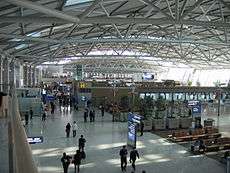
Air
Incheon International Airport is South Korea's primary international airport and a regional air hub. In 2015, it was the world's 22nd busiest airport by passenger traffic, with 49,412,750 passengers.[21]
There were a total of 305,446 flights (300,634 international, 4,812 domestic) to and from Incheon International Airport in 2015, an average of 837 flights (824 international, 13 domestic) daily. Korea's two main carriers, Korean Air and Asiana Airlines, serviced 50.9% of flights, while low-cost and foreign carriers serviced the remaining 49.1% of flights.[22] The airport is experiencing a rapid increase in passengers, and the opening of Terminal 2 in December 2017 spurred additional traffic.
The airport was also featured in the Korean drama series, "Air City."
Sea
Incheon's sea port is the second largest port in Korea after Busan Port.
The International Passenger Terminal located at the port offers ferries to five cities in China: Dalian, Qingdao, Tianjin, Dandong, and Weihai. There are also ferries to Incheon's outlying islands as well as Baengnyeong Island inside of the Northern Limit Line.
Buses
Incheon Bus Terminal, located at its eponymous subway stop, offers express bus transportation to all parts of Korea. Many city bus lines offer transportation within city limits as well as to the neighboring cities of Bucheon, Gimpo, Seoul, and Siheung.
Many BRT lines offer transportation between Seoul and Incheon.
Train
Local service to Guro, Seoul, Cheongnyangni, Uijeongbu and Soyosan is offered by Seoul's subway Line 1. The line has 11 stations within Incheon and connects to the Incheon Subway at Bupyeong and Juan stations.
Rapid service on the same line to Yongsan Station in Seoul depart from Dongincheon station and stops at major stations.
The Airport Express (AREX) line runs from Incheon International Airport to Seoul Station via Gimpo International Airport. The Incheon-Gimpo section was opened in March 2007 and was extended to Seoul station in December 2010. Passengers can choose a high-speed service stopping only at Incheon airport and Seoul, which takes 43 minutes but departs only every half-hour; or the all-station service which takes 53 minutes but leaves every six minutes.
KTX service was introduced on the AREX line on 30 June 2014, with stops at Incheon International Airport Station and Geoman Station. There are additional plans to use the newly built Suin Line to bring KTX service to Incheon Station by 2021.[23]
Subway
The Incheon Subway has two subway lines serving the city. The first line connects to the Seoul Metropolitan Subway system at Bupyeong Station (Seoul Subway Line 1), and AREX line at Gyeyang Station. It connects International Business District Station in Songdo to Gyeyang Station. The line has 28 stations on 29.4 kilometres (18.3 miles) of track. The line also has transfer stations with the Suin Line at Woninjae Station, with the Incheon Subway Line 2 at Incheon City Hall Station, and with Seoul Subway Line 7 at Bupyeong-gu Office Station. Incheon Subway Line 2 opened in July 2016 and runs from Geomdan Oryu Station to Unyeon Station. The automated line is 29.2 kilometres (18.1 miles) long, and has 27 stations, including transfer stations at Geomam Station with the AREX line, Juan Station with Seoul Subway Line 1 and Incheon Subway Line 2 at Incheon City Hall Station.
The Incheon subway is operated by the Incheon Rapid Transit Corporation (IRTC).
There are additional plans for a third subway line in Incheon.
Korail has also constructed a new commuter rail line named Suin Line. The line opened in 2012 from Oido Station in Siheung to Songdo Station in Incheon. It was then extended in 2016, and now reaches Incheon Station where passengers can transfer to Seoul Subway Line 1. In 2017, the line will be extended from Oido Station to Suwon Station.
SMRT (one of three operating companies of Seoul Metropolitan Subway) has extended Seoul Metropolitan Subway Line 7 to Bupyeong-gu office by 2011 and provided transfers to the Incheon Subway system. It has 3 stations within Incheon. By 2020, he line will further be extended westwards to Seoknam Station where it will be possible to transfer to Incheon Subway Line 2.
Free Economic Zone
The Incheon Free Economic Zone consists of the three regions of Songdo, Cheongna, and the island of Yeongjong, and has a total area of 51,739 acres (20,938 ha). The goal of IFEZ is to transform these three areas into hubs for logistics, international business, leisure, and tourism for the Northeast Asian region. The term 'Free Economic Zone' applies to the development in these three areas with the aim of improving the business environment for foreign-invested enterprises and the living conditions for foreigners. The zone is a specially designated area to create the most favorable business and living environment where foreign nationals can live and invest freely and conveniently. Incheon's Free Economic Zone, the first in Korea, was officially designated by the Korean government in August 2003. IFEZ is planned to be a self-contained living and business district featuring air and sea transportation, a logistics complex, an international business center, financial services, residences, schools and hospitals, and shopping and entertainment centres.
New Songdo City
Songdo International City began development in 1994 and is being built on reclaimed land. It is designated to become a center of diverse international businesses, a hub for international trade, an area for knowledge-based technologies, and a place for eco-friendly urban living. Construction is due to be completed in 2020.
- Development size: 13,162 acres (53.26 km2)
- Planned population: 252,000 persons
- Construction duration: 1994~2020
Yeongjong Island
As of 2012, Yeongjong International City’s 34,183 acres (13,833 ha) centering on the Incheon International Airport is being developed as an eco-friendly airport city scheduled to be completed by 2020. Paradise Co, a South Korean casino operator, said in October 2013 that it will build the country's largest casino on Yeongjong Island.[24]
Cheongna
The Cheongna district, on the mainland adjacent Yeongjong Island, will focus on entertainment and will feature a world class theme park. It will also be a residential area with sports facilities, a floriculture complex, and a business area specially designed for international finance.
- Development Size: 4,394 acres (1,778 ha)
- Planned population: 90,000 persons
- Duration: 2004~2008
Administrative divisions
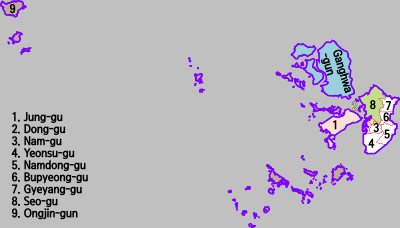
Incheon is divided into 8 districts (gu) and 2 counties (gun).
- Bupyeong District (Korean: 부평구; Hanja: 富平區)
- Dong District (동구; 東區)
- Gyeyang District (계양구; 桂陽區)
- Jung District (중구; 中區)
- Michuhol District (미추홀구; 彌鄒忽區)
- Namdong District (남동구; 南洞區)
- Seo District (서구; 西區)
- Yeonsu District (연수구; 延壽區)
- Ganghwa County (강화군; 江華郡)
- Ongjin County (옹진군; 甕津郡)
Demographics
| Year | Pop. | ±% p.a. |
|---|---|---|
| 1950 | 258,000 | — |
| 1960 | 394,000 | +4.32% |
| 1970 | 627,000 | +4.76% |
| 1980 | 1,062,000 | +5.41% |
| 1990 | 1,785,000 | +5.33% |
| 2000 | 2,371,000 | +2.88% |
| 2010 | 2,559,000 | +0.77% |
| 2019 | 2,938,457 | +1.55% |
| source:[25] | ||
Religion in Incheon (2005)[26]
According to the census of 2005, of the people of Incheon 36.1% follow Christianity (22.4% Protestantism and 13.7% Catholicism) and 13.8% follow Buddhism.[26] 50.1% of the population is mostly not religious or follow Muism and other indigenous religions.
Sports
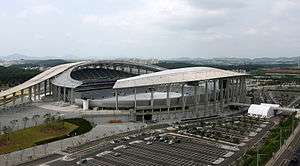
Incheon is home to the following professional and semi professional sports teams:
Association football:
The K League 1 team Incheon United FC.
The Incheon team was known to have a popular rivalry against former Bucheon SK (now Jeju United), due to the teams' close geographical relationship.
The WK League team is named Hyundai Steel Red Angels.
Baseball:
The KBO League team SK Wyverns.
The first Incheon-based pro-baseball team was Sammi (one of the major steel companies in the 1980s) Superstars.
Basketball: The KBL team Incheon Electroland Elephants and WKBL team Incheon Shinhan Bank S-Birds are based in Incheon.
Ice hockey: The Daemyung Killer Whales of the Asia League Ice Hockey play their games at Incheon's Seonhak Ice Rink.
Volleyball: The V-League teams are Incheon Korean Air Jumbos and Incheon Heungkuk Life Pink Spiders.
Munhak Sports Complex: The Munahk Sports Complex houses both a football stadium and a baseball stadium. The football stadium was Incheon's venue for the 2002 Football World Cup, and is also the home venue for Incheon United. The baseball stadium is the home venue for the SK Wyverns.
In April 2007, Incheon was selected as the host city for the 2014 Asian Games, beating out New Delhi.[27]
Yeonhui Cricket Ground: Yeonhui Cricket Ground is a purpose-built cricket stadium in Incheon built for Cricket at the 2014 Asian Games. The 2014 Asian Games featured cricket for both the men's and the women's event and this ground was used for the scheduled cricket matches played in the games. It has been reported that the crowd capacity of this ground to be 2,353. This first cricket stadium in South Korea.[28][29]
Incheon Football Stadium (Sungui Arena): Incheon Football Stadium is the first football-only stadium in Incheon. It was built in 2012 with a capacity for 20,891 spectators.
Points of interest
A number of Korea's western islands, including Ganghwa Island, Yeongjong Island, and Baengnyeong Island are also administered by Incheon. Baengnyeong Island is South Korea's westernmost point.
- Bupyeong Station is where the Seoul Subway Line 1 and Incheon subway line intersect. There is a large under ground shopping center there mostly selling trendy women's clothing and cell phones. Above ground, there are many restaurants, additional shops, and a Lotte Mart. Bupyeong Station Underground Shopping Centre has 1,408 stores in 31,692m (official statistics from the National Archives of Korea), was officially certified as the place with the largest number of stores in the world by American World Record Academy in November 2014.
- Jayu (Freedom) Park is a park near the city's port. The statue of General Douglas MacArthur, as well as a memorial to the centennial anniversary of U.S. and Korea relations is located there.
- Chinatown is Korea's only official Chinatown, located across from Incheon Station near Jayu Park.
- Incheon Bus Terminal refers to an area surrounding the city's bus terminal. There is also a performance venue and a subway station. Within this area of Guwol-dong is Rodeo Street, a busy central square packed with restaurants and department stores.
- Wolmido is the location of Green Beach, one of the landing sites for MacArthur's invasion force. It is now a local tourist attraction with a boardwalk, an amusement park and many raw fish restaurants. Ferries run from Wolmido to Yeongjongdo and Jakyakdo.
- Jakyakdo is a tiny island located in the harbor close between Wolmido and Yeongjongdo. There are many walkways and picnic spots, a restaurant, and seasonal rental rooms.
- Incheon Landing Operation Memorial Hall is a plaza and small museum dedicated to the Incheon Landing. Weapons and artifacts from the war and operation are displayed.
- Incheon Dohobu Cheongsa is the old government complex for Incheon. Located near Munhak Stadium, it has existed since at least the reign of King Sejong, about 1424 AD.
- Ara Canal is a waterway connecting the Han River and the Yellow Sea. Along the canal is a park and a bike path that is increasingly becoming popular with the locals.
- Korean-chinese cultural center was built by the Jung-gu District of Incheon to facilitate mutual understanding between Korea and China.
- Songwol-dong Fairy Tale Village was born from a renovation project to improve the envelopment of the village, and is now a main attraction amongst young people and children.
- Peking opera wallis located in the heart of the Chinatown.
 Monument to 100 years of friendship between Korea and the US in Jayu Park
Monument to 100 years of friendship between Korea and the US in Jayu Park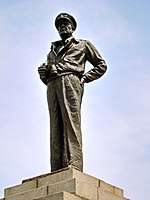 The statue of MacArthur at Jayu Park
The statue of MacArthur at Jayu Park A walkway in Jayu Park
A walkway in Jayu Park The only official Chinatown in South Korea
The only official Chinatown in South Korea Peking Opera wall Chinatown, Incheon, South Korea
Peking Opera wall Chinatown, Incheon, South Korea Korean-chinese cultural center Chinatown in South Korea
Korean-chinese cultural center Chinatown in South Korea Songwol-dong Fairy Tale Village in Incheon in South Korea
Songwol-dong Fairy Tale Village in Incheon in South Korea Port of Incheon
Port of Incheon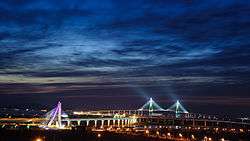
 The tiny island of Jakyakdo
The tiny island of Jakyakdo Wolmido promenade
Wolmido promenade
Notable people
- Hapkido Grand Master Bong Soohan
- Myung Jaenam
- Kim Ryeowook, Super Junior
- Kim Hyoyeon, Girls' Generation
- Kim Yoo-hyeon, Dreamcatcher (group)
- Park Chae-won, Loona
- Choi Minho, Shinee
- Kim Gura
- Kim Namil, footballer
- Cho Yonghyung, footballer
- Shin Ji, Koyote
- Yoon Chae-kyung, APRIL
- Kang Hyejung, actress
- Kim Eunjung, footballer
- Lee Sunghyun, kickboxer
- Choi Ji-man, baseball player (New York Yankees, Milwaukee Brewers, Tampa Bay Rays)
- Bang Yongguk, B.A.P
- Goo Hyesun, actress
- Hyolyn, Sistar
- Roh Jihoon, singer under Cube Entertainment
- Ryu Hyunjin, baseball player (Hanwha Eagles, Los Angeles Dodgers, Toronto Blue Jays)
- Park Choa, AOA
- Bang Minah, Girl's Day
- Kang Daesung, BIGBANG
- Nam Jihyun
- Kyung Soo-jin
- Kim Young-kwang
- Sohyang, singer, author
- JinJoo Lee, DNCE
- Seo Jisoo, Jung Yein, Kei, Lovelyz
- Jung Ye-rin, Kim Ye-won, GFriend
- Ong Seong-wu, Wanna One
- Han Ji-sung, Stray Kids
- Kim Wonpil, Day6
- Rhythm Power members
- Yoo Seung-Ho
- Kim Younghoon, Lee Jaehyun THE BOYZ
- Song Mingi, Ateez
- Lee Kang-In footballer
- Jung Seung-hwan, singer
- Kim Sung-joo, singer, actor, UNIQ
- Choi Jisu(Lia), ITZY
International relations





















See also
- List of Korea-related topics
- List of cities in South Korea
- List of East Asian ports
- Battle of Chemulpo Bay
- Inchon (film)
- Incheon Chinatown
References
- 연령별 인구현황 [Population by Age]. mois.go.kr.
- Incheon Metropolitan City Archived 7 January 2006 at the Wayback Machine
- Ewing, Stefan (25 January 2006). "By Train from Seoul to Incheon – and Jemulpo, too". Korea Web. Archived from the original on 28 September 2007.
- Prior to 1973, the township belonged to Bucheon or old Bupyeong.
- Bill Sloan, The Darkest Summer: Pusan and Inchon 1950: The Battles That Saved South Korea—and the Marines—From Extinction(2009)
- "G20 Information Centre". utoronto.ca.
- Garcia, Cathy Rose A. (30 July 2009). "Spotlight on Women Artists at Incheon Biennale". Korea Times. Archived from the original on 11 August 2011.
- "- Olympic Council of Asia". www.ocasia.org. Retrieved 18 February 2019.
- "Arirang News". Arirang.co.kr. 20 March 2007. Retrieved 13 May 2013.
- "Overseas Chinese primary and middle, high school, Incheon". International School Information, Government of South Korea. Archived from the original on 30 March 2016.
- Kottek, M.; J. Grieser; C. Beck; B. Rudolf; F. Rubel (2006). "World Map of the Köppen-Geiger climate classification updated" (PDF). Meteorol. Z. 15 (3): 259–263. Bibcode:2006MetZe..15..259K. doi:10.1127/0941-2948/2006/0130. Retrieved 8 December 2012.
- Peel, M. C.; Finlayson B. L. & McMahon, T. A. (2007). "Updated world map of the Köppen–Geiger climate classification" (PDF). Hydrol. Earth Syst. Sci. 11 (5): 1633–1644. Bibcode:2007HESS...11.1633P. doi:10.5194/hess-11-1633-2007. ISSN 1027-5606.
- http://meteo.geo.uni.lodz.pl/icuc5/text/P_2_4.pdf
- "Inchon, Korea: Climate, Global Warming, and Daylight Charts and Data". climate-charts.com.
- "AsiaRooms – LateRooms – Last Minute Hotel Deals & Cheap Hotels". asiarooms.com.
- 평년값자료(1981–2010), 인천(112) (in Korean). Korea Meteorological Administration. Retrieved 8 December 2016.
- 기후자료 극값(최대값) 전체년도 일최고기온 (℃) 최고순위, 인천(112) (in Korean). Korea Meteorological Administration. Retrieved 8 December 2016.
- 기후자료 극값(최대값) 전체년도 일최저기온 (℃) 최고순위, 인천(112) (in Korean). Korea Meteorological Administration. Retrieved 8 December 2016.
- "Climatological Normals of Korea" (PDF). Korea Meteorological Administration. 2011. p. 499 and 649. Archived from the original (PDF) on 7 December 2016. Retrieved 8 December 2016.
- 송도국제도시 세계 최대 바이오의약품 생산기지로 뜬다 [Songdo International City becomes the world's largest biopharmaceutical production base] (in Korean). 12 October 2015. Archived from the original on 14 October 2015.
- "Year to date Passenger Traffic: December 2015". Airports Council International (ACI). Archived from the original on 29 January 2017.
- Airport Statistics: 인천공항 [Airport Statistics: Incheon International Airport] (in Korean).
- Bae, Joon-yong (19 April 2016). 인천역에 KTX 들어오나? [Will KTX come to Incheon station?]. Incheon Daily News (in Korean). Archived from the original on 8 August 2016.
- Kim, Peter (22 October 2013). "New casino complex to be built near Incheon airport". The Korea Observer. Archived from the original on 14 November 2016.
- World Urbanization Prospects
- "2005 Census – Religion Results".
- Yoo, Soh-jung (6 July 2010). "2014 Asian Games to promote regional harmony". The Korea Herald. Archived from the original on 19 April 2014.
- "INCHEON PUTTING IN THE HARD YARDS". Asian Cricket Council. 4 December 2013. Retrieved 13 July 2019.
- "Yeonhui Cricket Ground (Incheon Asian Games 2014)". modernseoul.org. 4 December 2013. Retrieved 13 July 2019.
- "Sister Cities & Affiliated Cities". incheon.go.kr. Incheon Metropolitan Government. Retrieved 13 April 2020.
External links
- Government Website of Incheon Metropolitan City
- National Institute of Biological Resources on Google Cultural Institute
- "2015년 인구주택총조사 전수집계결과 보도자료" [2015 Population and Housing Census]. Statistics Korea.

